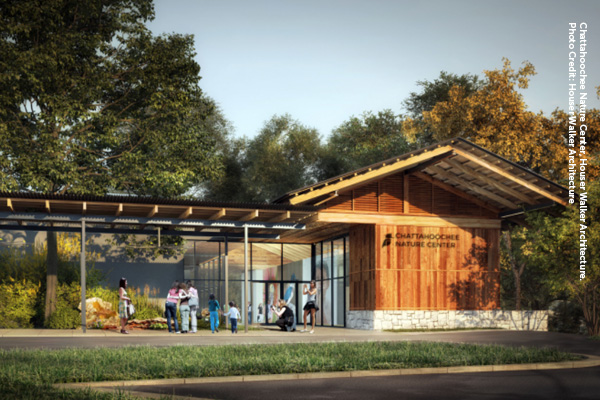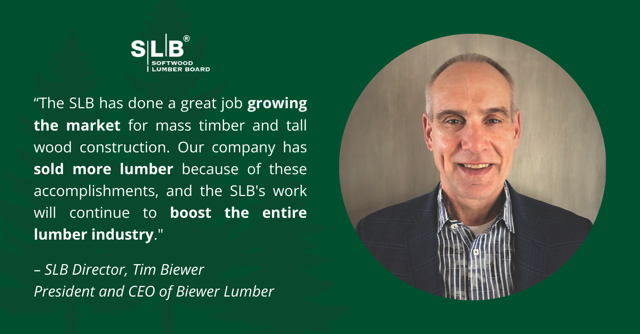HIGHLIGHTS
PROGRAM UPDATES
The AWC Tackles Wildland-Urban Interface Work In Co-Producer Role, WoodWorks Continues to Energize the International Mass Timber Conference Football Champion–Turned–Wood Champion Delivers Stirring Talk to Architecture Students and Faculty Founders Hall Video Showcases Wood Construction’s Education Sector PotentialProgram Updates
The AWC Tackles Wildland-Urban Interface Work
California experienced multiple catastrophic wildfires in the early days of January, with 38,000 acres burned and estimates of over $100 billion in damages. This has brought increased national attention and concern over building in the wildland-urban interface (WUI). The American Wood Council (AWC) has been actively involved over many years in technical research and WUI code development in California and nationally. This experience has helped the AWC to engage early and effectively in the aftermath of the California wildfires to support performance-based standards that provide adequate fire resistance instead of ignition resistance or noncombustible material requirements that unfairly exclude wood products.
To support the continued use of a performance-based, fire-resistance approach in WUI standards, the AWC ran four fire tests last year at the Western Fire Center in Kelso, Washington, providing critical data that the AWC is already using in California to address WUI-related concerns, specifically any attempts to unfairly bar wood products in certain WUI-designated areas.
In California last year, the AWC’s efforts preserved the technical requirements of 2022 CA Building Code Chapter 7A for use of wood in exterior applications, such as siding and decking, in the new CA WUI Code. These have been forwarded to the California Building Standards Commission for final consideration and, if approved, will likely become central to the rebuild efforts in Los Angeles.
As WUI codes and home hardening continue to be important conversations throughout California and the United States, the AWC is engaged in postfire activities in California and in the development of the 2027 International Wildland Urban Interface Code (IWUIC). The AWC’s long-standing, science-driven engagement on this issue has built credibility and relationships with key organizations and leaders, providing the AWC with a strong platform to support appropriate approaches to home hardening and fire resistance that do not unfairly target wood products.
In Co-Producer Role, WoodWorks Continues to Energize the International Mass Timber Conference
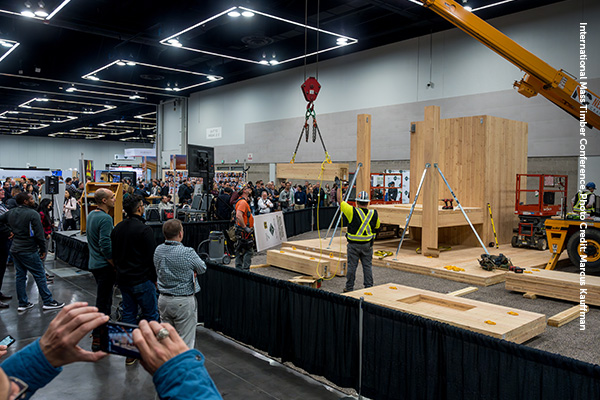
This week, more than 3,000 professionals are gathered in Portland, Oregon, for the International Mass Timber Conference. As co-producer with Trifecta Collective, which purchased the successful event last year, WoodWorks once again played a leadership role in the structure and programming, helping to shape a worthwhile experience for teams looking to build their mass timber expertise.
WoodWorks’ efforts touched almost every aspect of the conference. Among the highlights, WoodWorks:
- Hosted a free pass giveaway, emphasizing applicants with real projects underway. The organization received 783 applications—each a potential project lead—and selected 100 developers and building designers where the additional education and networking were most likely to have a tangible impact on market growth.
- Guided the development of five education tracks, including a developer track delivered collaboratively with the Urban Land Institute—made possible by WoodWorks’ ULI Corporate Partnership.
- Organized and delivered a preconference mass timber bootcamp so attendees with less experience could develop a baseline of education and get more value from the conference. This also introduced WoodWorks to architects, engineers, and construction professionals who may need support to move a project forward.
- Provided targeted education for contractors with a “live build” of a mass timber mock-up on the trade show floor, supported by resources like WoodWorks’ U.S. Mass Timber Construction Manual and the paper How to Successfully Cost Manage a Mass Timber Project.
- Hosted a roundtable meeting for North American insurance providers and wood industry leaders to discuss insurance-related barriers to market growth.
- Led a meeting of mass timber manufacturing partners to discuss the market and how WoodWorks can continue supporting their needs. WoodWorks partners include all the major U.S. mass timber manufacturers and nearly all the major Canadian producers.
Think Wood complements WoodWorks’ role at the Mass Timber Conference with a booth promoting Think Wood’s educational resources, allowing design professionals to continue their own wood education path. With WoodWorks’ technical expertise and market insights, the program has helped energize the International Mass Timber Conference year after year, making it the most well-attended education event for those interested in mass timber building design and construction.
Football Champion–Turned–Wood Champion Delivers Stirring Talk to Architecture Students and Faculty
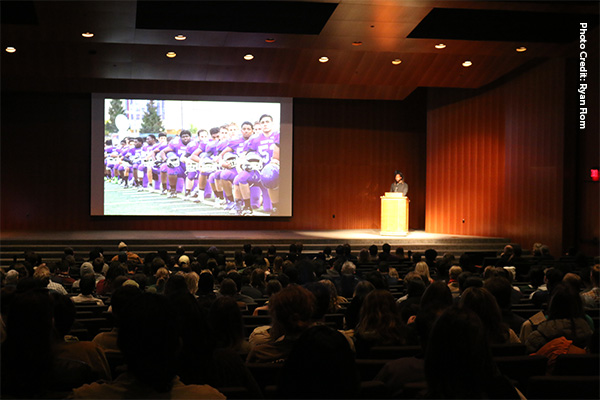
Former pro football champion and Seattle Seahawk Michael Bennett delivered the keynote address on behalf of SLB Education, which engages higher-education audiences under the Think Wood brand, to a packed auditorium of architecture students and faculty attending the AIAS FORUM conference at the University of Texas at Austin in January. Bennett shared his journey from professional football to design and architecture, driven by a passion for reclaiming public spaces and empowering communities through innovative design. He highlighted how mass timber, particularly CLT, enhances his projects by combining strength, versatility, and sustainability. His insights sparked thoughtful questions and positive feedback from engaged students and faculty.
AIAS FORUM, the organization’s largest annual event, drew over 400 architecture students from across the United States. Bennett’s talk perfectly aligned with the “Crossroads” theme, which focused on exploring critical decision points shaping the future of architecture, particularly around housing and carbon challenges. The keynote’s impact was further amplified as AIAS FORUM was colocated with ACSA’s Intersections Research Conference and attended by over 100 architecture faculty from schools nationwide examining new housing paradigms and innovative approaches to design, construction, and community development. By engaging both students and educators, Bennett’s talk fostered dialogue on sustainable, resilient built environments, while inspiring the next generation of architects to embrace wood as a core solution.
Founders Hall Video Showcases Wood Construction’s Education Sector Potential
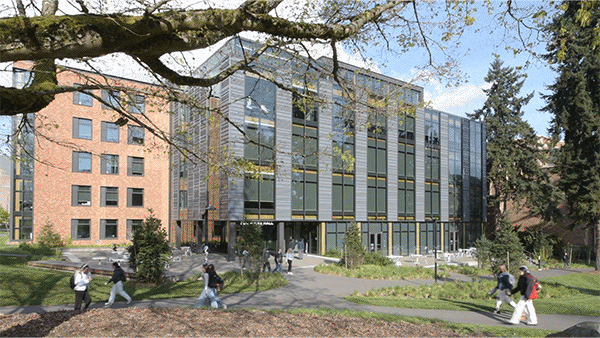
As pent-up demand from postponed projects boosts activity, the education sector represents a significant opportunity for the lumber industry, with 1.7 BBF of annual incremental volume potential from a mix of light-frame, mass timber, and steel-timber hybrid construction. The American Institute of Architects’ 2025 Construction Forecast projects the education market to grow by 4% this year, ahead of the 2% overall nonresidential growth rate.
Think Wood recently released a video demonstrating the opportunity for wood construction in the education sector with a profile of Founders Hall, an 85,000-square-foot building at the University of Washington’s Foster School of Business. Designed by LMN Architects, it features five stories of classrooms and flexible gathering spaces built with CLT, a choice that reflected the school’s commitment to decarbonization and biophilic design.
The project is resonating with Think Wood’s audience of architects, engineers, and developers across the country, and it’s already having an impact at the University of Washington. “Across the University of Washington campus, I often get the question, ‘How can we build with mass timber like you did?’” Foster School Dean Frank Hodge says in the video. “As we think about future expansion, other units on campus are thinking of building and are actually committing to building with mass timber.”
Spotlight
The Next Phase of Growth for Lumber Markets
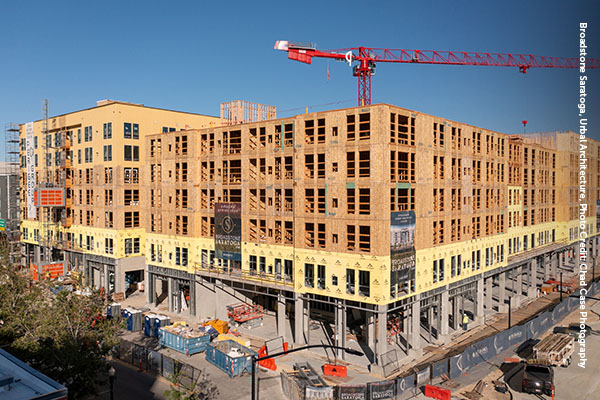
The SLB’s work to aggressively grow market share in nonresidential and multifamily construction has generated more than 15 BBF of incremental lumber demand since 2012.
This collaborative work has put the industry in a stronger position than ever before, but more can be done to accelerate the rate of market share capture. Here’s a look at how the SLB has found and converted opportunities for market growth—and where we see room for new gains in the years to come.
One of the opportunities the SLB has spotted is to expand wood’s role in steel and mass timber hybrid construction systems. Alongside organizations such as the World Steel Association, the SLB is promoting hybrid wood construction, encouraging builders to leverage the benefits of both materials to build efficient, cost-effective, lower-carbon buildings.
The SLB’s success in spurring new demand has been driven by trailblazers: early adopters of mass timber and taller multistory light-frame construction. Growing wood’s market share means appealing to design professionals and developers who value confidence: the reassurance of precedent and complete solutions over sustainability attributes and innovation. The industry must make mass timber and taller light-frame construction predictable: the easy, obvious, and most profitable solution.
Multifamily projects, affordable housing, education, and offices present the greatest opportunity to reach an incremental annual volume growth of 4.9 BBF—versus 1.6 BBF in 2024. The share of apartment buildings with 20 to 49 units has grown over five years from 26% to 34%, according to the U.S. Census Bureau. Today, light-frame construction represents 77% of the market share in the 1- to 4-story segment and 48% of the 5- to 8-story segment, offering significant incremental growth opportunities for lumber.
Education is another market with significant volume, as pent-up demand from postponed projects boosts activity and demographic trends lead the under-25 population to increase by nearly 2 million by 2030. With less than 5% of market share over the past six years and 1.7 BBF of annual potential, there is a significant margin for the taking, specifically in the K-12 segment. Offices and banks represent an additional 1.2 BBF of potential as developers look to differentiate their buildings with beautiful and biophilic wood-based construction systems that enhance the tenant experience.
With every accomplishment, we clarify a vision for what more we can do. It’s important for lumber producers of all sizes to align on a plan to accelerate demand for lumber, granting a new mandate for the SLB to forge a consensus path toward diversification and market expansion for our products. Read our full article on softwoodlumberboard.org to learn more about our vision for reaching lumber’s market share potential.
Industry Resources
FEA’s Housing Dashboard
These housing dashboards are provided compliments of Forest Economic Advisors (FEA).
View the February Housing Dashboard
View the March Housing Dashboard
Virginia Tech's Monthly Housing Report
This monthly housing commentary report is a free service of Virginia Tech and is intended to help one gauge future business activity in the U.S. housing market.
January 2025 Reports (released in March 2025)
Part A: January Housing Commentary
Part B: January Economic Conditions


